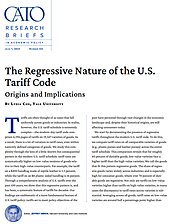We start by documenting the presence of regressive tariffs throughout the modern U.S. tariff code. To do this, we compare tariff rates on all comparable varieties of goods (e.g., plastic purses and leather purses) across the entire tariff schedule. This comparison reveals that for roughly 60 percent of dutiable goods, low-value varieties face a higher tariff than the high-value varieties. We call the goods that fit this pattern regressive goods. The share of regressive goods varies widely across industries and is especially high for consumer goods, where over 70 percent of dutiable goods are regressive. Not only are tariffs on low-value varieties higher than tariffs on high-value varieties, in many cases the discrepancy in tariff rates across varieties is substantial. Averaging across all goods, tariff rates on low-value varieties are around half a percentage point higher than tariff rates on high-value varieties, and among regressive goods, the average differential is around 4 percentage points.
Why are tariffs set in this regressive manner? The origins of the pattern are difficult to trace. Over the past 30 years— the period in which tariff data are readily available—relative tariff rates on low- versus high-value varieties have been remarkably persistent. Therefore, to understand when and why the divergence in rates occurred, we must look back further in time. We do this by constructing a new data set of digitized U.S. tariff schedules following every major trade agreement back to the 1930 Smoot-Hawley Tariff Act. After analyzing these new data, a clear picture emerges: regressive variation in tariff rates within goods began in the late 1930s, when the United States started to engage in bilateral negotiations to lower tariffs after the era of global protectionism that emerged with the passage of Smoot-Hawley. Throughout the multilateral trade negotiations known as the General Agreement on Tariffs and Trade (GATT), which began in 1947, tariff rates on all products were reduced, but regressivity was never eliminated.
Detailed case studies and further analysis of the data reveal two primary mechanisms that drove the regressive variation in tariff rate—concessions and protection. In many cases, tariff rates were reduced as concessions to important trading partners, who tended to be advanced economies producing higher-end varieties of goods. For example, the United States lowered tariffs only on expensive fishing reels as a concession to the UK because that was the variety the UK produced. This was part of a broader pattern between 1930 and 1946, where tariff rates on more expensive varieties of a subset of goods were reduced in concessions to trading partners by more than 20 percentage points more than tariff rates on the cheaper varieties. These forces likely continued during the GATT, as countries that were considered core participants of these negotiations were 25 percent more likely to export high-value varieties than noncore participants.
In other cases, tariff rates remained elevated on low-value varieties to protect a domestic industry from import competition. This led to regressivity in cases where the domestic industry specialized in production of a low-value variety. This “protection” mechanism was the driver of regressivity in the case of forks, for example, where U.S. producers specialized in and lobbied on behalf of a cheaper variety of stainless-steel fork but did not resist reductions in tariffs on more expensive, silver-plated forks. In most cases, tariff rates diverged to fulfill one of these two policy priorities decades ago, and the gap has persisted despite rates trending down as a whole and despite vast changes over this time in the countries the United States trades with and in what the United States produces.
Despite its historical origins, regressivity affects U.S. consumers today. Simple calculations reveal that consumers would save a little over $4 billion per year on imported goods if the regressive pattern were eliminated. These savings would likely not be shared equally across the income distribution: considering only the effects on consumer expenditures, individuals making $20,000 per year would see benefits from eliminating regressivity that would be four times larger than the benefits for individuals earning $100,000 per year. This is because lower-income individuals are more likely to consume the cheaper varieties of goods.
NOTE
This research brief is based on Miguel Acosta and Lydia Cox, “The Regressive Nature of the U.S. Tariff Code: Origins and Implications,” September 8, 2022.

